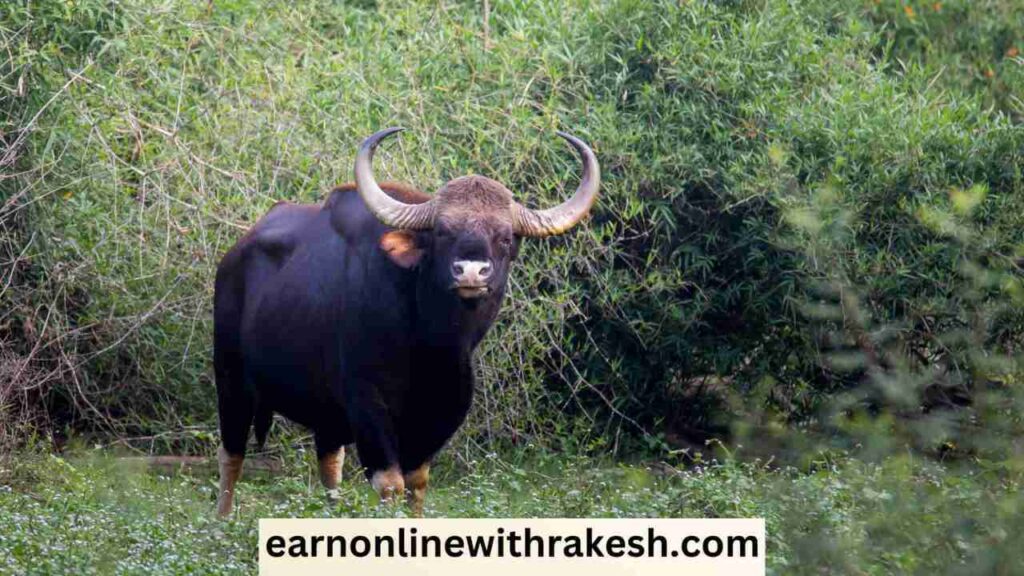Indian Bison Population Survey : In a groundbreaking effort, the Forest Department, in collaboration with wildlife authorities, has recently completed a meticulous survey to estimate the population of the Indian Bison, also known as the gaur, in the ecologically rich Papikonda National Park and adjacent forests.
Indian Bison Population Survey in Papikonda National Park and Surrounding Forests

Population Estimate and Species Identification:
Forest Department officials have reported a population of 375 Indian Bison inhabiting the lush landscapes of Papikonda National Park and the nearby forests. The Indian Bison, or gaur, is a formidable species known for its robust build and distinctive appearance.
ALSO READ : Revival of Rhinos in Assam : A Triumph in Wildlife Conservation
Survey Techniques and Duration:
The survey, conducted over the last three months, employed state-of-the-art methods to gather accurate data. Wildlife authorities utilized a combination of camera traps and foot patrolling to cover extensive areas, ensuring a comprehensive understanding of the Indian Bison population dynamics.
Expanded Geographical Scope: Holistic Assessment of Indian Bison Across Varied Habitats
The strategic decision to extend the survey’s reach beyond the confines of Papikonda National Park and into the Chintapalli and Paderu forests represents a visionary approach by wildlife officials. This expanded geographical scope demonstrates a steadfast commitment to not only comprehensively evaluate the distribution and abundance of Indian Bison but also to understand their dynamics in diverse and varied habitats.
1. Ecological Diversity Embraced: Papikonda National Park, Chintapalli, and Paderu forests collectively contribute to a mosaic of ecological diversity. By broadening the survey’s scope to encompass these varied habitats, wildlife officials acknowledge the importance of understanding the Indian Bison’s adaptability to different environmental conditions. This approach ensures a more holistic and nuanced understanding of the species’ ecological preferences and behaviors.
2. Identification of Key Habitats: The expansion of the survey allows for the identification of key habitats crucial for the Indian Bison’s survival. By covering a larger geographic area, wildlife officials can pinpoint regions that serve as critical corridors, breeding grounds, or feeding areas. This information is invaluable for formulating conservation strategies that prioritize the preservation and protection of these key habitats.
3. Corridor Connectivity: As the survey extends to Chintapalli and Paderu forests, it takes into account potential wildlife corridors connecting these diverse habitats. Recognizing the importance of unimpeded movement for the Indian Bison, authorities can now assess the connectivity between these regions. This information is essential for the development of conservation plans that safeguard the integrity of corridors, ensuring the free movement of the Indian Bison across their natural range.
4. Adaptive Conservation Planning: Diverse habitats come with unique challenges and opportunities. By expanding the geographical scope, wildlife officials can adapt conservation plans to address specific issues in each region. Whether it’s mitigating human-wildlife conflicts, preserving critical water sources, or managing vegetation dynamics, an expansive survey scope allows for the tailoring of conservation strategies to the intricacies of each habitat.
5. Community Involvement and Local Knowledge: Engaging with communities in Chintapalli and Paderu forests provides an opportunity to incorporate local knowledge into conservation efforts. Indigenous communities often possess valuable insights into the behavior and movement of wildlife. By including local perspectives, wildlife officials can enhance the effectiveness of conservation initiatives and foster collaborative efforts with the people living in close proximity to these diverse habitats.
6. Robust Data for Informed Decision-Making: Expanding the survey’s geographic scope contributes to the collection of robust and comprehensive data. The information gathered goes beyond a singular snapshot of the Indian Bison population and provides a dynamic understanding of how these animals interact with their environment across different landscapes. This wealth of data empowers wildlife officials with the knowledge needed for informed decision-making in the formulation of conservation policies and actions.
7. Conservation of Multiple Species: The expanded survey not only benefits the Indian Bison but also contributes to the conservation of other species inhabiting these diverse ecosystems. Understanding the interactions between the Indian Bison and other flora and fauna in Chintapalli and Paderu forests allows for the development of conservation strategies that promote the overall health and biodiversity of these regions.
Scientific Precision:
The scientific approach employed in this survey enhances the credibility of the findings. Camera traps, strategically placed in key locations, provided visual documentation, while foot patrolling allowed for on-the-ground observation and data collection. The integration of these methods ensures a robust and reliable estimate of the Indian Bison population.
Wildlife Conservation Implications: Nurturing Ecosystem Harmony Through Indian Bison Population Understanding
The insights gained from the exhaustive survey on the Indian Bison population in Papikonda National Park and the surrounding forests carry profound implications for wildlife conservation. The significance of understanding the population dynamics of the Indian Bison extends far beyond mere numerical representation; it serves as a cornerstone for the development of targeted conservation strategies, preservation of habitats, and the maintenance of crucial ecological balance within these vital forest ecosystems.
1. Targeted Conservation Strategies: The collected data provides a nuanced understanding of the Indian Bison population, including their distribution, behavior, and interactions with the environment. This wealth of information allows conservationists to tailor strategies that specifically address the needs and challenges faced by the Indian Bison. By focusing on targeted conservation efforts, authorities can maximize the impact of their initiatives, ensuring the sustainable growth and well-being of the species.
2. Habitat Preservation and Restoration: A detailed comprehension of the Indian Bison population dynamics facilitates strategic planning for habitat preservation and, where necessary, restoration. Conservationists can identify key areas critical to the species and implement measures to protect these habitats from encroachment or degradation. Additionally, restoration initiatives can be designed to revitalize ecosystems, creating a conducive environment for the Indian Bison to thrive.
3. Ecological Balance Maintenance: The Indian Bison plays a pivotal role in maintaining the ecological balance of the forest ecosystems. Their grazing habits, interactions with vegetation, and influence on other species contribute to the delicate balance of the ecosystem. With a clear understanding of their population dynamics, conservationists can ensure that the Indian Bison’s role is preserved, preventing disruptions that could have cascading effects on the entire ecosystem.
4. Biodiversity Conservation: Beyond the Indian Bison, the survey contributes to broader biodiversity conservation efforts. By studying the interactions between the Indian Bison and other flora and fauna in the region, conservationists gain insights into the interconnected web of life. This holistic approach enables the development of strategies that protect not only a single species but also the diverse array of life within the ecosystem.
5. Mitigation of Human-Wildlife Conflicts: Understanding the behavior and movement patterns of the Indian Bison aids in devising measures to mitigate potential conflicts with human activities. Conservationists can implement strategies to minimize crop depredation, secure livestock, and enhance safety for both local communities and the Indian Bison. This proactive approach fosters coexistence, reducing the likelihood of negative interactions between wildlife and human populations.
6. Climate Change Resilience: The survey data becomes a valuable resource in building resilience against the impacts of climate change. By understanding how the Indian Bison population responds to environmental changes, conservationists can develop adaptive strategies to safeguard the species in the face of shifting climate patterns, ensuring their long-term survival in a dynamic and unpredictable environment.
7. Scientific Research and Education: The wealth of data collected serves as a foundation for scientific research, enabling further studies on the Indian Bison’s ecology and behavior. This research contributes to the academic understanding of the species and fosters education and awareness programs. Public knowledge about the importance of the Indian Bison and the ecosystems they inhabit is crucial for garnering support for conservation initiatives.
Collaborative Effort for Biodiversity Preservation: A Model for Synergistic Conservation
The synergy between the Forest Department and wildlife authorities represents an exemplary collaborative endeavor, showcasing a profound commitment to the preservation of biodiversity in the ecologically sensitive regions of Papikonda National Park, Chintapalli, and Paderu forests. The joint efforts of these organizations not only highlight the importance of pooling resources but also set a precedent for proactive and holistic wildlife management.
1. Joint Expertise Utilization: The collaboration capitalizes on the specialized knowledge and skills of both the Forest Department and wildlife authorities. Forest officials bring expertise in habitat management, while wildlife authorities contribute insights into the behavioral patterns and ecological needs of the Indian Bison. This amalgamation of knowledge ensures a comprehensive and informed approach to biodiversity preservation.
2. Resource Optimization: Pooling resources is a hallmark of this collaborative effort. Both organizations share financial, technological, and human resources, optimizing their capabilities to conduct a thorough and sophisticated survey. This efficient resource allocation enables the implementation of large-scale initiatives, such as extensive camera trapping and foot patrolling, which are critical for obtaining accurate data on the Indian Bison population.
3. Integrated Planning and Strategy: The collaboration involves integrated planning and the formulation of comprehensive conservation strategies. By combining forces, the Forest Department and wildlife authorities develop initiatives that address not only the Indian Bison population but also the broader ecosystem. This holistic approach considers the interconnectedness of various species and ecological factors, ensuring a well-rounded strategy for biodiversity preservation.
4. Capacity Building: The collaborative effort extends beyond survey activities to encompass capacity building within the involved organizations. Skills and knowledge transfer between the Forest Department and wildlife authorities foster a mutual understanding of conservation challenges and solutions. This ongoing learning process enhances the collective capacity to tackle complex issues related to biodiversity and wildlife management.
5. Public Outreach and Education: Recognizing the importance of public support, the collaborative effort emphasizes public outreach and education. Joint initiatives aim to raise awareness among local communities about the significance of biodiversity preservation. Educational programs, workshops, and community engagement events foster a sense of shared responsibility and encourage active participation in conservation activities.
6. Adaptive Management: The collaboration embraces an adaptive management approach. Continuous communication and feedback mechanisms between the Forest Department and wildlife authorities allow for real-time adjustments to conservation strategies. This dynamic and responsive framework ensures that initiatives remain effective in the face of evolving environmental and ecological challenges.
7. Conservation Policy Advocacy: The collaborative effort extends to advocacy for conservation policies at regional and national levels. By presenting a united front, the Forest Department and wildlife authorities actively engage with policymakers, advocating for legislation that supports biodiversity preservation and sustainable wildlife management. This advocacy enhances the long-term impact of their joint conservation initiatives.
Future Initiatives: Addressing Challenges and Fostering Sustainable Coexistence
The data gleaned from the exhaustive survey has not only provided a snapshot of the current Indian Bison population but has also laid the groundwork for future initiatives aimed at promoting the coexistence of these magnificent creatures with their natural habitats.
1. Habitat Preservation and Restoration: Armed with precise information on the distribution of Indian Bison, conservationists can strategically focus on preserving and, where necessary, restoring habitats in Papikonda National Park, Chintapalli, and Paderu forests. This initiative involves safeguarding key areas critical to the well-being of the Indian Bison, ensuring a sustainable ecosystem for both flora and fauna.
2. Corridor Development: Identifying and establishing wildlife corridors is crucial for the Indian Bison’s movement between different habitats. The survey insights will guide the creation of well-designed corridors, facilitating the safe passage of these animals across fragmented landscapes. This initiative promotes genetic diversity and helps mitigate potential conflicts between wildlife and human activities.
3. Community Engagement and Awareness: Recognizing the significance of local communities in conservation efforts, future initiatives will emphasize community engagement and awareness programs. Involving the residents of nearby areas in conservation activities fosters a sense of shared responsibility and helps build a harmonious relationship between humans and the Indian Bison. Educational programs will highlight the importance of coexisting with these majestic creatures.
4. Monitoring and Research Programs: Continuous monitoring is essential to track changes in the Indian Bison population and their habitats over time. Future initiatives will include the establishment of long-term monitoring and research programs, leveraging advanced technologies and collaborative efforts. This ongoing commitment ensures that conservation strategies remain adaptive and responsive to evolving environmental conditions.
5. Mitigating Human-Wildlife Conflicts: Understanding the specific challenges faced by the Indian Bison population allows authorities to implement targeted measures to mitigate potential conflicts with human activities. This includes the development of effective strategies to reduce crop depredation, secure livestock, and enhance safety for both the local communities and the Indian Bison.
6. Conservation Funding and Partnerships: With a comprehensive understanding of the ecological needs of the Indian Bison, authorities can actively pursue funding opportunities and establish partnerships with conservation organizations. Financial support is crucial for implementing large-scale conservation projects, and collaborations broaden the impact of conservation initiatives, fostering a united front against biodiversity loss.
7. Adaptive Management Strategies: Recognizing the dynamic nature of ecosystems, future initiatives will prioritize adaptive management strategies. Flexibility in conservation planning allows authorities to respond promptly to unforeseen challenges, such as changes in climate patterns or emerging threats, ensuring the resilience of the Indian Bison population and their habitats.
Conclusion: Indian Bison Population Survey
The successful completion of this detailed survey marks a significant milestone in wildlife management and conservation. With 375 Indian Bison identified and documented, the data obtained will contribute to ongoing efforts aimed at ensuring the long-term survival and well-being of this iconic species in the pristine habitats of Papikonda National Park and its surrounding forests.














